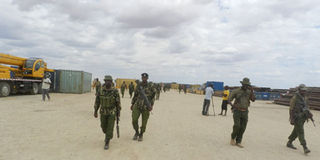The Turkana and Pokot have more in common than they would admit

Security personnel on patrol after Tullow staff packed to leave the work site after a series of demonstrations by residents in October, 2013.
Photo\PETER WARUTUMO
What you need to know:
- In 1986, the government in the figure of Daniel arap Moi and Nicholas Biwott contracted a French company, Spie Batignolles, to construct the Turkwell Gorge Power Plant on the Turkwell River.
- Sebet and Ortum have the largest uncapped deposits of limestone in East Africa but for a decade, fraudulent companies were transporting it to Tororo in Uganda until activists protested.
- The government’s decision to cooperate with Ethiopia over the Gibe III Dam on River Omo has put Lake Turkana at great risk, especially for fishermen and pastoralists.
Turkana is rarely out of the news these days and mostly for the wrong reasons. A month ago, demonstrations at Tullow Oil drilling plant led to a two-week shutdown.
That was followed by a five day siege at Lorogon that Cabinet Secretary Joseph Ole Lenku told us never happened. Finally, Turkana county was at the bottom of the great inequality report with a shocking 88 per cent of the population living in destitution.
Turkana would be written off as a failed state if it were a country. Maybe one day it will, should residents demand secession and declare Turkana si Kenya in a manner much more forthright and focused than the ragtag Mombasa Republican Council (MRC) outfit.
You could hardly blame them as half a century of independence has brought nothing but neglect, famine and grabbing of the resources that God endowed them with.
Life is not much better for the Pokot who share much more in common with their neighbours than divides them: deprivation, poor leadership, a proud culture, brave warriors and a love for freedom.
Were it not for missionaries, much less than six per cent of the Pokot and three per cent of Turkana would have gone beyond primary school.
Both communities have experienced government as a hostile force with little respect for their culture and little interest in their welfare.
The Lorogon incident needs analysis to understand why these communities are in constant conflict over matters not of their making.
In 1986, the government in the figure of Daniel arap Moi and Nicholas Biwott contracted a French company, Spie Batignolles, to construct the Turkwell Gorge Power Plant on the Turkwell River.
No feasibility study was conducted though geologists claimed it was built on a vault. The deal cost $250 million (Sh21.25 billion), and that later rose to $450 million (Sh38.3 billion) through kickbacks.
The dam was built on the border between the two counties. Neither community was consulted and when conflict arose as to who hosted it, the Kanu government responded by appointing a chief and APs from each county to the disputed location.
Lorogon sprung up as a Turkana village, while Pokots claimed it was in their land. Access to the river became a source of continuous conflict and the funds promised by Kerio Valley Development Authority (KVDA) to establish a joint irrigation project downstream never came.
Only after campaigns did the communities benefit from electricity yet even today only 2 per cent of Turkana households and 3 per cent of Pokots have power.
The government’s decision to cooperate with Ethiopia over the Gibe III Dam on River Omo has put Lake Turkana at great risk, especially for fishermen and pastoralists.
Sebet and Ortum have the largest uncapped deposits of limestone in East Africa but for a decade, fraudulent companies were transporting it to Tororo in Uganda until activists protested. Soon, hopefully, Pokot will have a cement factory.
Is it any wonder then that Turkanas are suspicious of what secret deals have been struck over the oil?
Turkana and Pokot representatives must invoke Article 188 of Constitution and accept the decision of a boundary commission.
A new peace would lead to developments and cooperation. It will also radically transform and benefit the communities.





